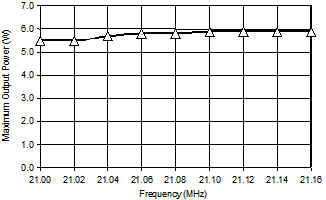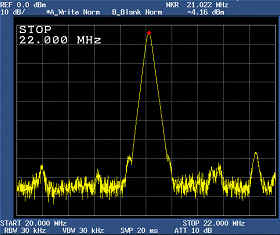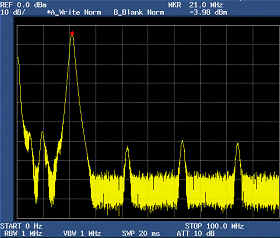| KB6MMS QRP and Simple Wire Antennas K1 Measured Performance on the 15 Meter Band |
|||
| Main My Station Kits Antennas Projects DX CW Logs Free Software |
15 Meter Band The 15m band, when open, becomes my favorite band. It has very little QRM and the results can be fantastic. The performance of the K1 on 15m is very good. I am happy with results in every way. On receive the rig is pretty quite and I get good reports. |
||
| Output Power I have included my test data for the maximum output power as a function of frequency from 21.000 MHz to 21.1600 MHz. The results show a pretty flat output power verses frequency characteristic. The minimum power is about 5.5W at 21.000MHz and peaks at about 5.9W for most of the tuning range. This is above the manufacture's advertised spec of 5.0W. Actually, Elecraft says "Adjustable CW power output, nominally 0-5 watts or higher." I am happy with this result. It looks like I may be able to retune the rig to get 5.9W over more of the lower part of the band. I don't think I will do that since I am just too lazy.
Configuration for this test
I conducted this test using my SWR meter/power meter manufactured by Diesel to monitor the power. I used my homebrew 50 ohm load. I know that the 50 ohm load is good because I measured the return loss to be better than 20dB to 60MHz. Just a quick note on measuring output power. I have seen some reports of output power and there is sometimes a comparison between output power into a 50ohm load and output power into an antenna. The two measured output powers are usually different and often the result into the antenna is higher. Now, I will give my two cents on this. The measurement into the antenna is really the wrong way to do it, unless your antenna has extremely good SWR. This is due to the fact that poor, or even pretty good SWR, will cause a larger voltage (voltage standing wave, hence VSWR) to be present at various points on the transmission line up to the antenna. This includes the coax between the rig and swr meter and everything up to the antenna. Since most, if not all, swr meters measure a voltage, any increase due to SWR issues will cause a false reading. Therefore, it is always best to measure output power into a know good 50 ohm load. OK that is my two cents on this issue.
|
|||
Maximum Tuning Range The K1 is advertised to cover "up to 150Kz" My measured results are below. As you can see the tuning range is well over the 150KHz soft spec. This is another good result. Minimum Frequency = 20.9892 MHz
|
|||
| RIT tuning Range I measured the RIT tuning range. I know this is not a real big issue for some. However, I do know that some DX stations like to work offset TX/RX. This is when a wide RIT can be helpful. Also, sometimes you get a contact where the other guy is off frequency by 1-2 KHz or more. This is very rare in my experience, but still happens. Anyway the results are below. The RIT range is about +/-4KHz. This is typical for all four bands. Minimum Frequency = 21.0166 MHz RIT Lower Range = 3.4 KHz
|
|||
| Spectral Purity The spectral purity of the transmitted signal was measured. Though it may come as a surprise to some, when your transmitter is tuned to, let's say, 7.040 MHz and you transmit, you will generate a signal at 7.040MHz plus other spurious and harmonic signals at other frequencies. Those spurious signals are not desired and in fact the level (or power level) of those undesired signals is controlled by FCC regulations. This spectral purity test directly measures the output from the transmitter over a very broad frequency range so that one can immediately see what is actually being transmitted. For instance, if you set your transmitter to 7.040MHz again and key it, it is likely that you will radiate some level of power at the harmonics. Those harmonics are at 14.080, 21.120, 28.160 MHz and so on. In addition, you may also be transmitting at other frequencies which are generated in the mixer stages, amplifiers and other non-linear elements in the transmitter. The frequency of those components is determined by several factors one of them is the IF frequency. These undesired signals are often called spurs which is short for spurious. The tests on the K1 were conducted using an Advantest R3273 Spectrum Analyzer with a bandwidth of 100Hz to 26.5 GHz. I know that that is way over the top as far as bandwidth overkill, but it was what I had available. I had 48.2dB of attenuation between the K1 and the Advantest.
|
|||



